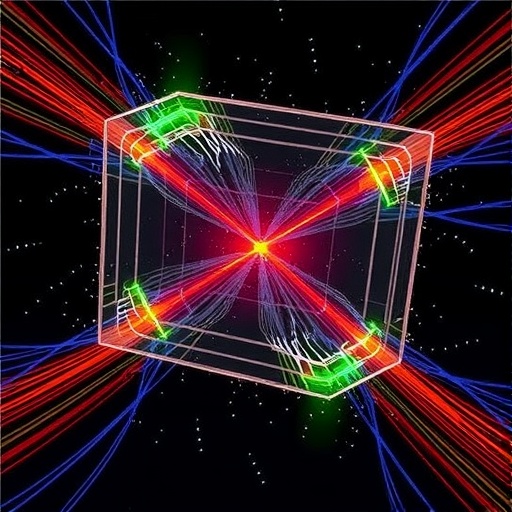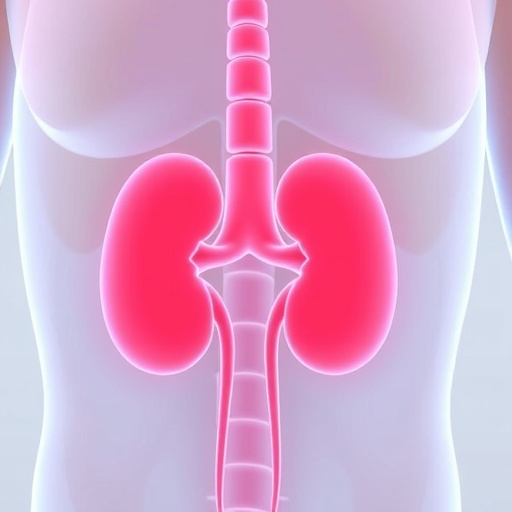In the rapidly evolving landscape of quantum materials, the discovery of novel superconducting phases continues to captivate researchers worldwide. Recently, a groundbreaking study has revealed the existence of topological nodal i-wave superconductivity on the surface of the Weyl semimetal PtBi₂. This finding unveils a rich playground where superconductivity intertwines with topological states, pushing the boundaries of condensed matter physics and opening new pathways toward quantum technology applications.
At the heart of this discovery lies the intricate electronic structure of PtBi₂, a material hosting 12 Weyl cones dispersed in momentum space. These Weyl points act as sources and sinks of Berry curvature, giving rise to surface states known as Fermi arcs. These arcs connect Weyl points in pairs and serve as conduits for electronic transport along the material’s surface. Crucially, when superconductivity sets in, it presents itself not throughout the bulk, but predominantly on the surface states, fundamentally reshaping the system’s low-energy excitations.
To probe this phenomenon theoretically, researchers employed an effective tight-binding model tailored to faithfully represent both lattice symmetries and the spatial arrangement of the Weyl cones in PtBi₂. This modeling approach carefully excludes trivial bands near the Fermi level, thereby isolating the essential physics driving the topological superconducting state. The model reveals that introducing surface superconducting pairing with A₂ symmetry gaps the Fermi arcs, spawning six Majorana cones on each surface of the crystal. These cones represent localized zero-energy excitations that are their own antiparticles, a hallmark of Majorana fermions.
Each Majorana cone is endowed with a nonzero winding number ±1, signaling topological protection guaranteed by the combined presence of time-reversal and particle-hole symmetries. This symmetry-respecting state belongs to class DIII within the Altland-Zirnbauer classification of superconductors, denoting systems that preserve time-reversal symmetry with spin-triplet pairing components. Intriguingly, contrasting with conventional strong topological superconductors, PdBi₂ remains metallic in the bulk and superconductivity emerges solely on the surface, thereby exemplifying a two-dimensional gapless topological phase that is ‘anomalous’.
The anomalous nature is underscored by the asymmetric winding numbers associated with surface Majorana cones: all cones on the top surface exhibit a winding of −1, while their counterparts on the bottom surface carry +1. This unconventional scenario defies realization in purely two-dimensional systems, where the sum of winding numbers cancels and the number of cones must be multiples of four. The delicate balance of topological invariants paints a complex picture of surface superconductivity, emphasizing the crucial role of crystalline symmetries such as threefold rotation and time-reversal symmetry in sustaining this phase.
Breaking time-reversal symmetry, for instance via an external magnetic field, dismantles the topological protection and gaps the Majorana cones, tuning the surface superconducting gap non-uniformly along the Fermi arcs. This prediction opens an experimental window to manipulate and detect signatures of topological superconductivity by investigating changes in the surface spectral gap under weak magnetic perturbations. Remarkably, when time-reversal symmetry is intact, the nontrivial winding numbers guarantee the existence of zero-energy Majorana modes localized at the hinges—where distinct crystal surfaces meet—thus extending the topological character of the system beyond purely planar geometries.
Computational studies on prism-shaped geometries of PtBi₂ support this framework by demonstrating hinge-localized zero modes arising between projections of Majorana cones from the top and bottom surfaces. The hinge modes occupy specific ranges of crystal momentum where the total winding number adds to ±2, and vanish or split away from zero energy outside these regions. As with the surface cones, these hinge states are sensitive to magnetic fields, shifting away from zero energy upon breaking time-reversal symmetry. This interplay between magnetic tuning and topological localization offers a concrete experimental signature accessible through advanced local probes at crystal edges.
Unraveling the microscopic origin of the unconventional i-wave pairing symmetry remains a compelling frontier. Unlike cuprate superconductors, where strong electron-electron interactions favor nodal d-wave channels, PtBi₂ exhibits highly delocalized electronic states with weak correlation effects. This suggests that conventional interaction-driven mechanisms may not explain the nodal superconductivity on its Fermi arcs. Instead, the robust topological character of these surface states likely plays a pivotal role, potentially leveraging nontrivial spin-momentum locking or other exotic effects inherent to Weyl physics. Deciphering this pairing mechanism promises to deepen our understanding of superconductivity emerging from topological electronic structures.
Despite the profound fundamental insights, the coexistence of gapless Majorana cones with a metallic normal-state bulk imposes significant challenges for leveraging PtBi₂ into quantum computing platforms. The presence of bulk modes undermines the isolation of topological quasiparticles, which are essential for fault-tolerant quantum operations. Nevertheless, the fabrication of ultrathin samples presents a promising route to mitigate unwanted bulk contributions, possibly isolating the desired surface superconducting phase. Moreover, engineering time-reversal symmetry breaking could stabilize gapped surface states harboring chiral Majorana edge modes or localized zero-dimensional Majorana bound states at corners—both widely advocated as building blocks for topological quantum computation.
Additionally, controlling the relative phase between the superconducting order parameters on the top and bottom surfaces introduces the tantalizing prospect of creating a planar Josephson junction within a single crystalline framework. Such junctions can harbor exotic Andreev bound states with nontrivial topological character, potentially functioning as qubits or topologically protected quantum gates. This sophisticated level of control would harness the inherent material symmetries and topological properties of PtBi₂ to engineer novel functionalities beyond what conventional superconductors can offer.
This comprehensive study not only spotlights PtBi₂ as a fertile platform to investigate a new class of nodal topological superconductors but also pushes the envelope of how symmetry, topology, and superconductivity intertwine in real materials. The confluence of theoretical modeling and experimental feasibility underscores the broader impact, aiding the design of future quantum devices that exploit surface-localized Majorana modes and hinge-localized states for robust and scalable quantum computation.
As research in this arena accelerates, the synergistic exploration of surface superconductivity, topological protection, and symmetry breaking promises to revolutionize our understanding of emergent quantum phases. PtBi₂ stands at the forefront, offering an unprecedented opportunity to meld fundamental physics with applied quantum technology, potentially ushering in the next generation of quantum materials and devices.
Subject of Research: Topological nodal i-wave superconductivity in Weyl semimetal PtBi₂.
Article Title: Topological nodal i-wave superconductivity in PtBi₂.
Article References: Changdar, S., Suvorov, O., Kuibarov, A. et al. Nature 647, 613–618 (2025). https://doi.org/10.1038/s41586-025-09712-6
Image Credits: AI Generated
DOI: 20 November 2025
Tags: Berry curvature and Weyl pointselectronic structure of PtBi2Fermi arcs in topological materialslow-energy excitations in superconductorsquantum materials researchquantum technology applicationssuperconducting phases discoverysurface states and superconductivitytight-binding model in condensed matter physicstopological nodal i-wave superconductivitytopological states in condensed matterWeyl semimetal PtBi2





